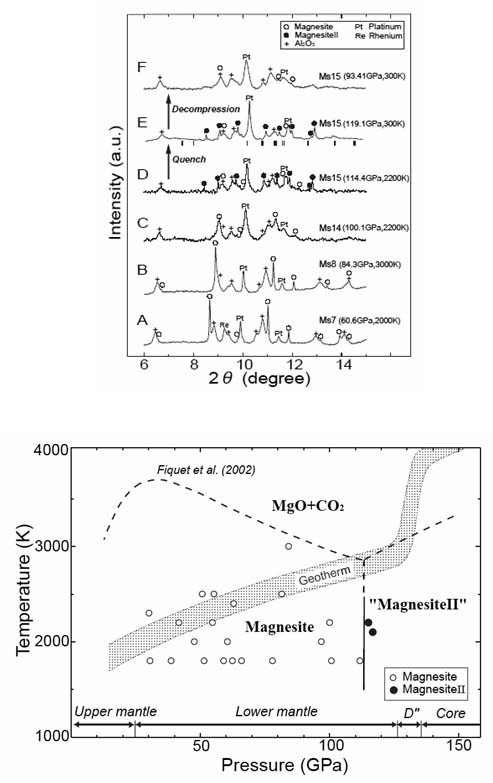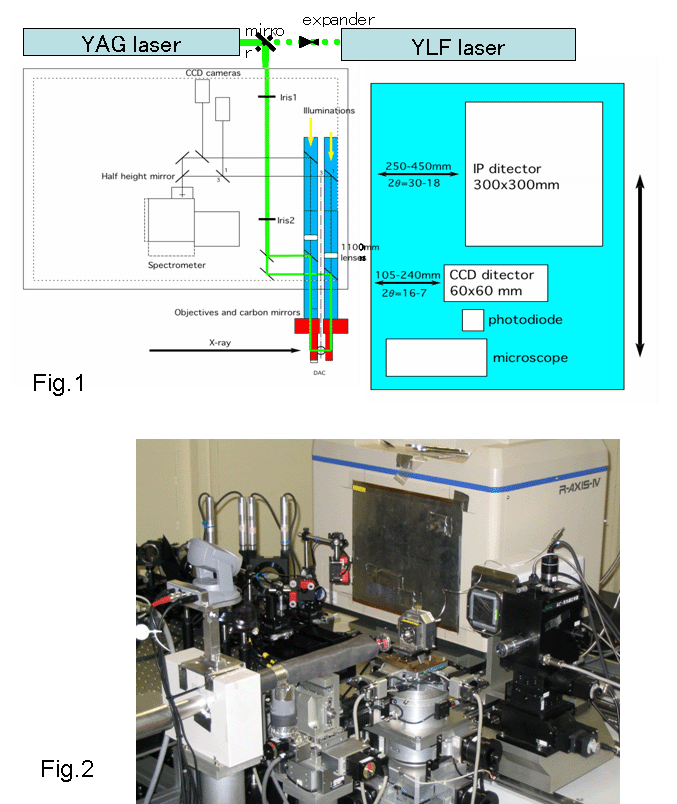Stability of magnesite and its high-pressure form in lowermost mantle
問い合わせ番号
SOL-0000001079
ビームライン
BL10XU(高圧構造物性)
学術利用キーワード
| A. 試料 | 無機材料 |
|---|---|
| B. 試料詳細 | 絶縁体・セラミックス, 結晶, 鉱物・岩石 |
| C. 手法 | X線回折 |
| D. 手法の詳細 | 粉末結晶構造解析 |
| E. 付加的測定条件 | マイクロビーム(>10μm), 高圧(DAC), 高温(>>500度) |
| F. エネルギー領域 | X線(4~40 keV) |
| G. 目的・欲しい情報 | 結晶構造, 相転移 |
産業利用キーワード
| 階層1 | 工業材料, その他 |
|---|---|
| 階層2 | |
| 階層3 | |
| 階層4 | 格子定数, 結晶構造, 結晶弾性率 |
| 階層5 | 回折 |
分類
A80.30 無機材料, M10.20 粉末結晶回折
利用事例本文
The x-ray diffraction with the use of the DAC/LH (diamond anvil cell / laser-heating) system is a powerful technique to study in-situ structural observations of materials under high-pressure/temperature. Using this technique, one can measure the crystal structures of the mantle minerals or materials of the core under the inner-earth condition. The figure shows the x-ray diffraction profile changes and the phase diagram of magnesite (MgCO3) under the lower mantle pressure/temperature condition (30-120GPa/2000-2500K). These data reveal the fact that the magnesite transforms to an unknown form without any dissociation at the condition of 115GPa/2100K (depths of about 2600km) (M.Isshiki et al., Nature, 427(2004)60).
Figure. X-ray diffraction profiles and phase diagram of magnesite.
[ M. Isshiki, T. Irifune, K. Hirose, S. Ono, Y. Ohishi, T. Watanuki, E. Nishibori, M. Takata and M. Sakata, Nature 427, 60-63 (2004), Fig. 1, 2,
©2004 Nature Publishing Group ]
画像ファイルの出典
原著論文/解説記事
誌名
Nature, 427(2004)60
図番号
1,2
測定手法
The DAC/LH (diamond anvil cell / laser-heating) technique can realize the environment of about 300GPa/4000K by delivering the focused laser beam (about 1 um wavelength) into the DAC sample chamber. Furthermore, the in-situ structural analysis can be performed under the high pressure/temperature condition by using the synchrotron x-ray diffraction.
Figure. schematic view and photograph of the LH system.
画像ファイルの出典
私信等、その他
詳細
JAMSTEC Nagayoshi Sata
測定準備に必要なおおよその時間
3 時間
測定装置
| 装置名 | 目的 | 性能 |
|---|---|---|
| Laser-heating system | high pressure/temperature | 300GPa, 4000K |
参考文献
| 文献名 |
|---|
| 廣瀬敬、高圧力の科学と技術、14(2004)255 |
関連する手法
アンケート
SPring-8だからできた測定。他の施設では不可能もしくは難しい
本ビームラインの主力装置を使っている
同種実験は本ビームラインの課題の30%以上を占めている
最近2年以内に導入した装置を使った事例
測定の難易度
熟練が必要
データ解析の難易度
中程度
図に示した全てのデータを取るのにかかったシフト数
4~9シフト


